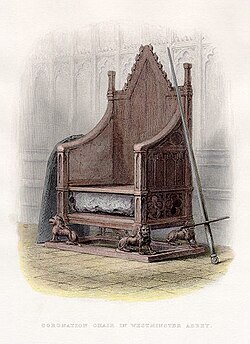Reino de Alba
Este artigo ou secção contém uma lista de referências no fim do texto, mas as suas fontes não são claras porque não são citadas no corpo do artigo, o que compromete a confiabilidade das informações. (Junho de 2019) |

O Reino de Alba é referente ao período do Reino da Escócia compreendido entre a morte de Donald II, ano 900, e a de Alexandre III em 1286 que levou às Guerras de independência da Escócia. Alba é o nome em gaélico escocês da Escócia e é utilizado precisamente por nesta época ser a elite de cultura gaélica e mais tarde normando-escocesa, em contraposição com a época dos Stuarts na que a elite era na sua maior parte de cultura anglo.
Corte
[editar | editar código-fonte]Não se conhece a estrutura da Corte escocesa antes da chegada dos normandos à Escócia. No século XII os principais cargos da Corte eram:
- Senescal ou dapifer, hereditários desde o reinado de David I, tinha ao seu cuidado a casa do rei.
- Chanceler, tinha ao seu cargo a capela real que estava associada com os copistas reais, responsáveis de manter a documentação. Era um sacerdote.
- Chamberlain, tinha o controle e a responsabilidade das finanças reais.
- Condestável, hereditário desde David I, tinha a seu cargo os recursos militares da coroa.
- Mordomo
- Marechal, era o responsável da cavalaria real.
No século XIII, todos os oficios exceto o de chanceler tenderam a ser hereditários ao tempo que se criaram outros oficios, o mais importante era o hostarius, a cargo da guarda real.
Origem
[editar | editar código-fonte]Donald II foi o primeiro que recebeu o nome de rei de Alba (rí Alban), concretamente à sua morte no castelo de Dunnottar no ano 900. Os seus predecessores recebiam o nome de reis dos pictos ou rei de Fortriu.
Fontes
[editar | editar código-fonte]Fontes primárias
[editar | editar código-fonte]- Anderson, Alan Orr, Early Sources of Scottish History: AD 500–1286, 2 Vols, (Edinburgh, 1922)
- Anderson, Alan Orr, Scottish Annals from English Chroniclers: AD 500–1286, (London, 1908), republished, Marjorie Anderson (ed.) (Stamford, 1991)
- Gerald of Wales, The History and Topography of Ireland, tr. John O' Meary, (London, 1982)
- Guillaume le Clerc, Fergus of Galloway, tr. D.D.R. Owen, (London, 1991)
- Skene, William F. (ed.), Chronicles of the Picts and Scots: And Other Memorials of Scottish History, (Edinburgh, 1867)
Fontes secundárias
[editar | editar código-fonte]- Bannerman, John, "MacDuff of Fife," in A. Grant & K.Stringer (eds.) Medieval Scotland: Crown, Lordship and Community, Essays Presented to G.W.S. Barrow, (Edinburgh, 1993), pp. 20–38
- Bannerman, John, “The Kings Poet”, in The Scottish Historical Review, V. LXVIII, (1989)
- Barron, Evan MacLeod, The Scottish War of Independence: A Critical Study, 2nd Edition, (Inverness, 1934)
- Barrow, G.W.S., The Anglo-Norman Era in Scottish History, (Oxford, 1980)
- Barrow, G.W.S., Feudal Britain, (London, 1956)
- Barrow, G.W.S., The Kingdom of the Scots, (Edinburgh, 2003)
- Barrow, G.W.S., Kingship and Unity: Scotland, 1000–1306, (Edinburgh. 1981)
- Barrow, G.W.S., “The Reign of William the Lion”, in Scotland and Its Neighbours In the Middle Ages, (London, 1992), pp. 67–89
- Barrow, G.W.S., Robert Bruce and the Community of the Realm of Scotland, (Edinburgh, 1988)
- Bartlett, Robert, The Making of Europe, Conquest, Colonization and Cultural Change: 950–1350, (London, 1993).
- Broun, Dauvit “Defining Scotland and the Scots Before the Wars of Independence,” in Image and Identity: the Making and Remaking of Scotland through the Ages, in. D. Broun, R. Finlay & M. Lynch (eds.), (Edinburgh 1998), pp. 4–17
- Broun, Dauvit, "Dunkeld and the origin of Scottish identity", in Innes Review 48 (1997), pp. 112–24, reprinted in Spes Scotorum: Hope of Scots, eds. Broun and Clancy (1999), pp. 95–111
- Broun, Dauvit, “Gaelic Literacy in Eastern Scotland between 1124 and 1249” in Huw Pryce (ed.), Literacy in Medieval Celtic Societies, (Cambridge, 1998), pp. 183–201.
- Broun, Dauvit, The Irish Identity of the Kingdom of the Scots in the Twelfth and Thirteenth Centuries, (Woodbridge 1999)
- Broun, Dauvit & Clancy, Thomas Owen (eds.),Spes Scottorum: Hope of the Scots, (Edinburgh, 1999)
- Broun, D., "The Welsh identity of the kingdom of Strathclyde, ca 900–ca 1200", in Innes Review 55 (2004), pp. 111–80.
- Davies, R.R., The First English Empire: Power and Identity in the British Isles 1093–1343, (Oxford, 2000)
- Driscoll, Steven, Alba: The Gaelic Kingdom of Scotland AD 800–1124, (Edinburgh, 1996)
- Ferguson, William, The Identity of the Scottish Nation: An Historic Enquiry, (Edinburgh, 1998)
- Gillingham, John, The Angevin Empire, (London, 1984)
- Gillingham, John, The English in the Twelfth Century: Imperialism, National Identity and Political Values, (Woodbridge, 2000)
- Hudson, Benjamin T., Kings of Celtic Scotland, (Westport, 1994)
- Lynch, Michael, Scotland: A New History, (Edinburgh, 1992)
- McDonald, R. Andrew, "Old and new in the far North: Ferchar Maccintsacairt and the early earls of Ross" in Steve Boardman and Alasdair Ross (eds.) The Exercise of Power in Medieval Scotland, c. 1200–1500, (Dublin/Portland, 2003)
- McDonald, R. Andrew, Outlaws of Medieval Scotland: Challenges to the Canmore Kings, 1058–1266, (East Linton, 2003)
- MacLeod, W., Divided Gaels: Gaelic Cultural Identities in Scotland and Ireland: c. 1200–1650, (Oxford, 2004)
- Neville, Cynthia J., Native Lorship in Medieval Scotland: The Earldoms of Strathearn and Lennox, c. 1140–1365, (Portland/Dublin, 2005)
- Oram, Richard, The Lordship of Galloway, (Edinburgh, 2000)
- Owen, D.D.R., The Reign of William the Lion: Kingship and Culture, 1143–1214, (East Linton, 1997)
- Roberts, John L., Lost Kingdoms: Celtic Scotland in the Middle Ages, (Edinburgh, 1997)
- Stringer, Keith J., "The Emergence of a Nation-State, 1100–1300", in Jenny Wormald (ed.), Scotland: A History, (Oxford, 2005), pp. 38–76
- Young, Alan, "Buchan in the 13th century" in Alexander Grant & Keith J. Stringer (eds.) Medieval Scotland: Crown, Lordship and Community Essays Presented to G.W.S Barrow, (Edinburgh, 1993)

